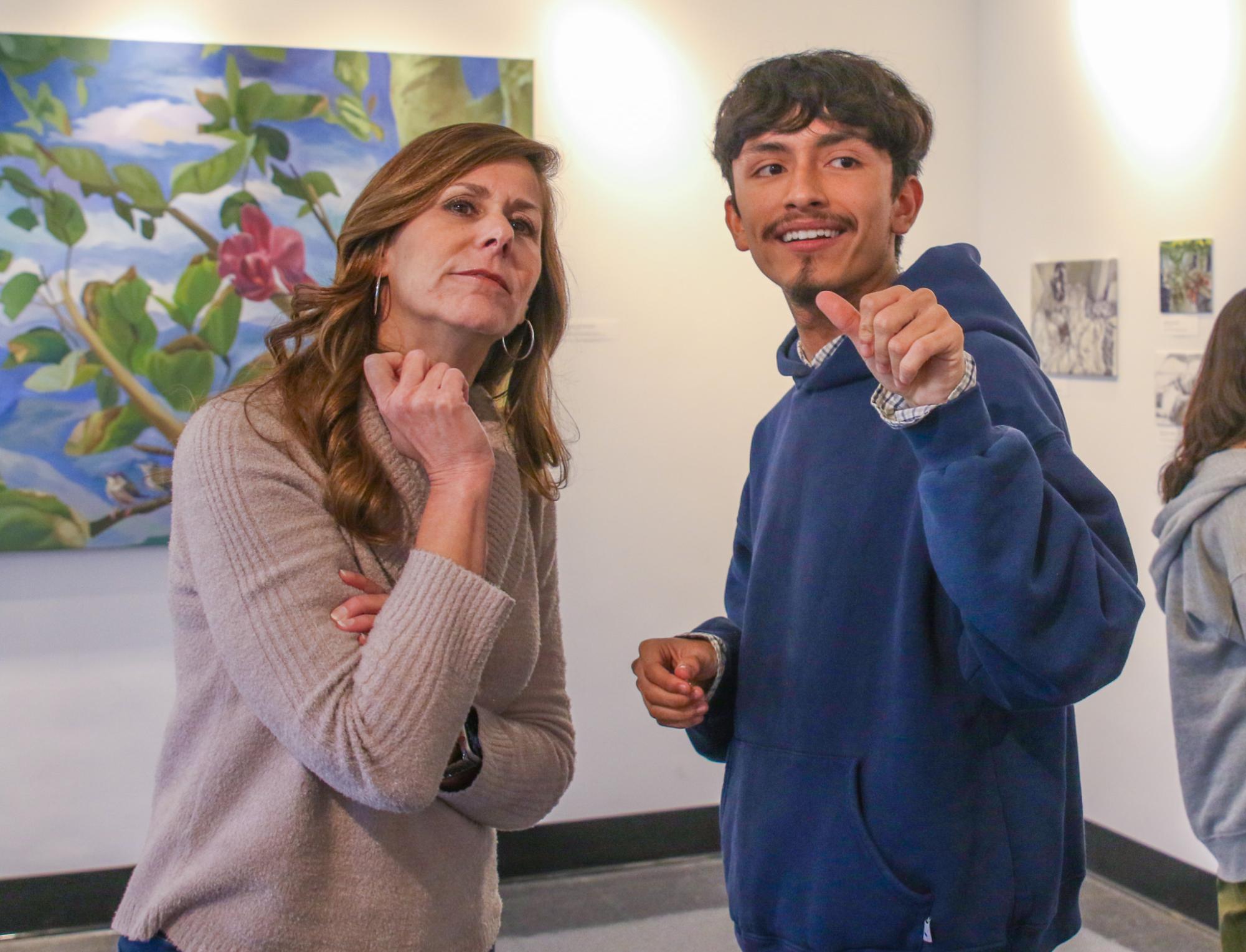A correction was made to this story on 1/24/2025. The incorrect spelling was used in the caption “Visual senior Thomas Diaz shows principal Blake Bennet around the art gallery where his pieces are being displayed.” The spelling “Bennet” has been changed to the correct spelling “Bennett.”
A correction was made to this story on 1/30/2025. The incorrect major was used in the caption “Looking at paintings, visual sophomore Samantha Harvey, digital media sophomore Madeline Miller, and visual sophomore Gabrielle Knowles visited visual senior Thomas Diaz’s art gallery. This display was available for students to see during lunch Jan. 10 and for the general public after school Jan. 13. Not only was this a chance for a senior student to display his pieces, but also for his peers to closely observe his creations. “This year I have to do AP art, and (I got to see) how he built his SI (sustained investigation) throughout the year,” Knowles said. “Seeing how he used his technique in painting really inspired me to further improve my artwork.” The major “digital media” has been changed to the correct major “visual.”
The overhead lights in Building 9 accentuated each line, mark, and brushstroke in the pieces hanging on the white walls. Some attendees studied pieces silently, while others engaged in conversation, debating the art’s potential meaning. In the midst of it all, the visual senior responsible for all the work in the gallery, Thomas Diaz, stood as students and teachers crowded around him to congratulate him on this achievement and listen to him describe the display.
Diaz’s first showing of the collection took place during lunch Friday, Jan. 10, exhibiting 18 paintings, a sketch, two in-progress paintings, as well as a written statement. His collection was divided into two different categories of work: “Instances – mundane moments focusing on the archetypes of everyday things,” and “Fabricated Memories – where the foreground is imagery from America and the background is imagery from Colombia.”
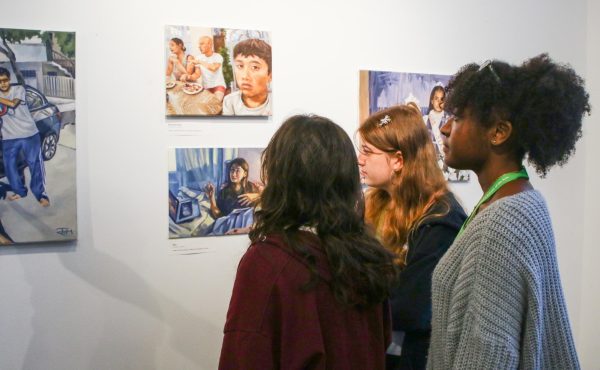
(Valentina Saenz-Daza)
His cultural background as an immigrant from Colombia is the inspiration for many of his pieces. Diaz said he portrays the immigrant experience through “(his) own eyes and through (his) family’s.”
“I was born in Colombia, and I came here around nine years ago,” Diaz said. “A lot of my work focuses on exploring the missed opportunity that immigrating can cause and (the) certain aspects of (your) culture that are lost or begin to fade as soon as you find yourself in a foreign country.”
To create his “Instance” pieces, Diaz used what he described as straightforward, day-to-day scenarios to show the “beauty of the little things” in life. In his painting “Había Silencio, Un Silencio Amoroso,” he depicts his grandmother on the couch completing a crossword puzzle, his brother on the floor resting against the couch, and his mother on a phone call.
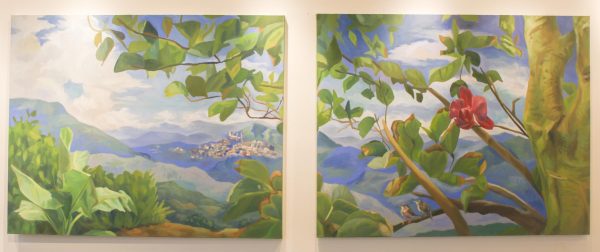
(Valentina Saenz-Daza)
“(The scenes are) things that people can identify and be like, ‘Okay, this is a shot of life,’” Diaz said. “I’m using the simplicity of realism to portray something deeper.”
Diaz explained that to create the pieces, he first posed his family for a picture and later painted based off of the image. He directed the scene so that it would be a collage of their authentic everyday life.
“I just wanted it (the ‘Instance’ collection) to look candid and for it to represent that want for normalcy, since a lot of times, (because of) the immigrant experience and living in the United States, there’s a lot of issues and a lot of stress,” Diaz said. “Everyone can relate to that feeling where you just want a moment of peace and normalcy.”
Some paintings in the collection focus mostly on the people in the painting, while others feature a landscape. Visual arts teacher Marcella Ramos Castillo, who has Diaz in her AP 3D art class, explained her thoughts on Diaz’s work.
“I think there (are paintings) that stand out for their technical prowess, but there are some pieces where the composition speaks to you more,” Ms. Ramos said. “I think a big contender (for my favorite) would be the family scene, (‘Había Silencio, Un Silencio Amoroso’).”
Diaz’s “Fabricating Memories” pieces are created through joining his present and his past. He described the process as superimposing moments or memories of his life here in the United States in the foreground of the piece with moments from Colombia in the background.
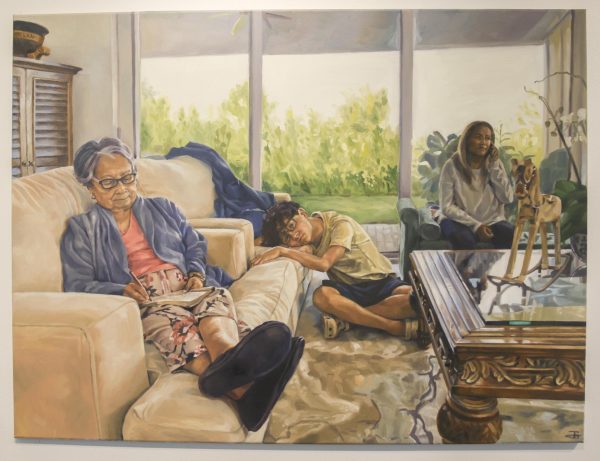
“In one (piece of) artwork, the foreground has my brothers biking, and then the background is my hometown, (Cali), in Colombia,” Diaz said. “It represents that desire for those special everyday moments to happen back in Colombia (and) a longing for the experiences I had back there and the memories that never were.”
His superimposed paintings are a result of his “yearning for both homes,” a visual representation of how although he stands on another country’s soil, his previous home is “often on (his) mind.” Taking inspiration from the impressionists, Diaz described his art as “realism,” despite his belief that abstract art could potentially portray emotions better.
“I’ve always found that there’s such beauty in the limitations of realism because having to portray something that actually exists in real life allows you to be more interesting with the way you do things,” Diaz said.
Each painting has an English description along with its Spanish translation. Diaz made it a point to translate every written part of the gallery, including the statement, for his family.
“Of course, if I’m going to have writing, it’s going to have to be in Spanish too,” Diaz said. “Because that dual(-language) thing is basically the whole point. When my family comes and sees it, they have to be able to read and interpret (it). Only doing it in English would be a disservice because (my parents) can completely understand, probably more than me, the sort of longing of being an immigrant, because they did it when they were older.”
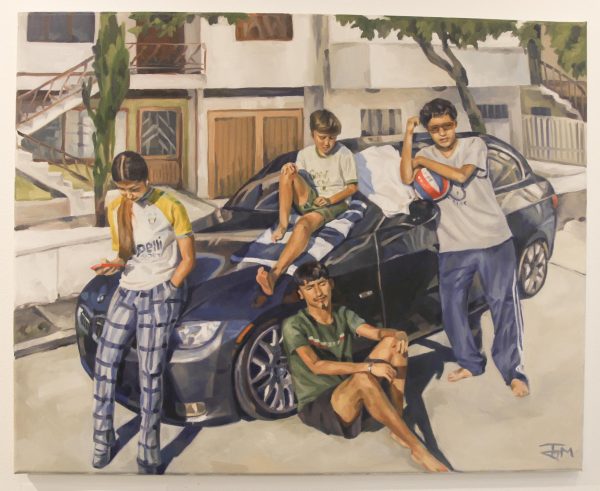
(Valentina Saenz-Daza)
Diaz’s younger brother, visual freshman Jeronimo Diaz, is featured in various paintings, including “Había Un Silencio, Un Silencio Amoroso,” “Pal Parque, Toco Mecato!”, “La Misa Ya Paso,” and “Colseguros.”
“I honestly didn’t expect to be in so many and that shook me, because I never thought of myself as his muse,” Jeronimo Diaz said. “I think he’s my inspiration to get better at art.”
Visual freshman Emmy Harkin said that she drew inspiration from Diaz’s gallery, particularly from his “breathtaking” use of color and oil paints on canvas.
“I think that all of the paintings are incredible, with a lot of attention to detail and strong compositions,” Harkin said. “I see his work with oil paints on canvases, and that’s a medium that I like to use, but I’m not entirely sure how. So I think that it’s quite inspiring to be able to see someone successfully use it and in a way that looks photo-realistic. I’ve come to him for advice on how to use oil paints before, and he was kind and explained it really well. I’ve seen him do that with many other people.”
Diaz said he believes in the importance of “creating pieces for yourselves,” especially considering he had no original guarantee he would get his pieces displayed.
“Even though I didn’t make (the pieces) with the intent of showing (them), it was amazing to see that people got what I intended by just looking at (them),” Diaz said. “That’s just a mark for a successful work of art for me. Having the message transcend your own personal imagination and introspection, extend into the masses, and allow other people to see themselves in the work, is very important.”



